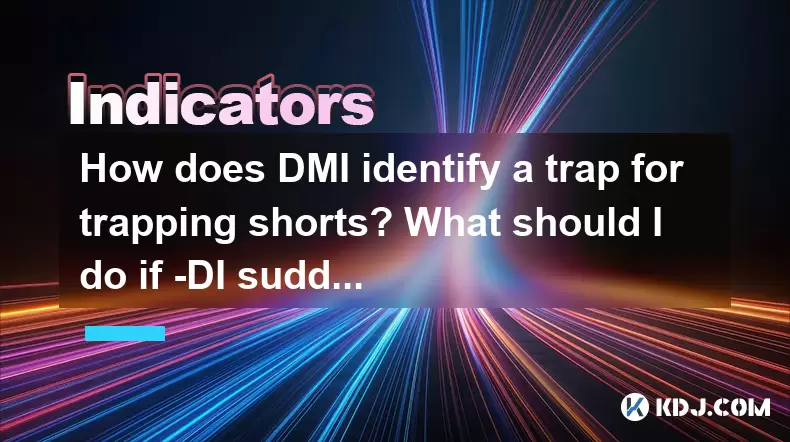-
 bitcoin
bitcoin $87959.907984 USD
1.34% -
 ethereum
ethereum $2920.497338 USD
3.04% -
 tether
tether $0.999775 USD
0.00% -
 xrp
xrp $2.237324 USD
8.12% -
 bnb
bnb $860.243768 USD
0.90% -
 solana
solana $138.089498 USD
5.43% -
 usd-coin
usd-coin $0.999807 USD
0.01% -
 tron
tron $0.272801 USD
-1.53% -
 dogecoin
dogecoin $0.150904 USD
2.96% -
 cardano
cardano $0.421635 USD
1.97% -
 hyperliquid
hyperliquid $32.152445 USD
2.23% -
 bitcoin-cash
bitcoin-cash $533.301069 USD
-1.94% -
 chainlink
chainlink $12.953417 USD
2.68% -
 unus-sed-leo
unus-sed-leo $9.535951 USD
0.73% -
 zcash
zcash $521.483386 USD
-2.87%
How does DMI identify a trap for trapping shorts? What should I do if -DI suddenly reverses after a rapid rise?
DMI helps identify traps for trapping shorts; if -DI reverses after a rapid rise, close shorts, enter longs, and set stop-losses to manage risk.
Jun 06, 2025 at 05:21 am

In the world of cryptocurrency trading, understanding technical indicators can significantly enhance your ability to make informed decisions. One such indicator is the Directional Movement Index (DMI), which traders use to gauge the strength of a trend and identify potential traps. This article delves into how DMI can help identify traps for trapping shorts and what steps to take if the -DI line suddenly reverses after a rapid rise.
Understanding the Directional Movement Index (DMI)
The Directional Movement Index (DMI) is a technical indicator developed by J. Welles Wilder to assess the strength of a trend. It consists of three lines: the Positive Directional Indicator (+DI), the Negative Directional Indicator (-DI), and the Average Directional Index (ADX). The +DI measures upward movement, the -DI measures downward movement, and the ADX indicates the strength of the trend, regardless of direction.
The +DI line is represented in green and helps traders identify bullish trends. The -DI line is represented in red and is used to identify bearish trends. The ADX line, typically in black, helps traders understand the overall strength of the trend. A rising ADX indicates a strengthening trend, while a falling ADX suggests a weakening trend.
Identifying a Trap for Trapping Shorts Using DMI
Traps for trapping shorts occur when the market tricks bearish traders into selling, only for the price to reverse and move upwards. DMI can help identify such traps by signaling a potential shift in momentum.
To identify a trap for trapping shorts using DMI, follow these steps:
- Monitor the -DI and +DI lines: A trap for trapping shorts is likely when the -DI line rises above the +DI line, signaling a bearish trend. However, if the -DI line starts to decline and the +DI line begins to rise, it could indicate a reversal and a potential trap.
- Watch the ADX line: The ADX line should be above 25 to indicate a strong trend. If the ADX is high and the -DI line starts to decline while the +DI line rises, it suggests that the bearish trend is losing strength, and a trap might be forming.
- Look for divergence: If the price continues to fall but the -DI line starts to decline, this divergence can signal a potential trap. The declining -DI line indicates weakening bearish momentum, which could lead to a reversal.
What to Do If -DI Suddenly Reverses After a Rapid Rise
A sudden reversal of the -DI line after a rapid rise can be a critical signal for traders. This scenario suggests that the bearish momentum is waning, and a potential bullish reversal could be imminent. Here's what you should do if you encounter this situation:
- Confirm the reversal: Before taking any action, confirm the reversal by checking other technical indicators such as the Relative Strength Index (RSI) or Moving Average Convergence Divergence (MACD). If these indicators also suggest a bullish reversal, it strengthens the case for a potential trap.
- Adjust your position: If you are holding a short position, consider closing it to avoid potential losses. If you are not currently in a position, consider entering a long position to capitalize on the expected bullish reversal.
- Set stop-loss orders: To manage risk, set a stop-loss order just below the recent low. This will help you exit the position if the market moves against your expectations.
- Monitor the trend: Continue to monitor the DMI lines and the ADX to ensure the bullish trend is gaining strength. If the +DI line continues to rise above the -DI line and the ADX remains high, it confirms the bullish reversal.
Practical Example of Identifying a Trap for Trapping Shorts
Let's walk through a practical example to illustrate how to identify a trap for trapping shorts using DMI:
- Initial Setup: You notice that the -DI line has been rising above the +DI line, indicating a bearish trend. The ADX line is above 25, confirming a strong trend.
- Potential Trap: Suddenly, the -DI line starts to decline, and the +DI line begins to rise. The price, however, continues to fall, creating a divergence.
- Confirmation: You check the RSI and MACD, which also suggest a potential bullish reversal. The RSI is moving out of oversold territory, and the MACD line crosses above the signal line.
- Action: You decide to close your short position and enter a long position. You set a stop-loss order just below the recent low to manage risk.
- Monitoring: You continue to monitor the DMI lines. The +DI line rises above the -DI line, and the ADX remains high, confirming the bullish reversal.
Using DMI in Conjunction with Other Indicators
While DMI is a powerful tool, it is most effective when used in conjunction with other technical indicators. Combining DMI with indicators like RSI, MACD, and Bollinger Bands can provide a more comprehensive view of the market and help you make more informed trading decisions.
- RSI: The Relative Strength Index can help confirm overbought or oversold conditions. If the RSI is moving out of oversold territory while the -DI line declines, it strengthens the case for a bullish reversal.
- MACD: The Moving Average Convergence Divergence can help identify potential trend reversals. A bullish crossover (MACD line crossing above the signal line) can confirm a bullish reversal indicated by the DMI.
- Bollinger Bands: Bollinger Bands can help identify volatility and potential price breakouts. If the price breaks above the upper Bollinger Band while the +DI line rises above the -DI line, it suggests a strong bullish trend.
Adjusting Trading Strategies Based on DMI Signals
Your trading strategy should be flexible enough to adapt to the signals provided by the DMI. Here are some ways to adjust your strategy based on DMI signals:
- Trend Following: If the ADX is high and the +DI line is above the -DI line, it suggests a strong bullish trend. Consider entering long positions and holding them until the ADX starts to decline.
- Trend Reversal: If the -DI line suddenly reverses after a rapid rise, it suggests a potential bullish reversal. Adjust your strategy to close short positions and consider entering long positions.
- Range Trading: If the ADX is below 25, it suggests a weak trend and a potential range-bound market. In this case, consider range trading strategies, such as buying at support levels and selling at resistance levels.
Frequently Asked Questions
Q: Can DMI be used for all cryptocurrencies, or is it more effective for certain types?A: DMI can be used for all cryptocurrencies, but its effectiveness may vary depending on the liquidity and volatility of the specific cryptocurrency. For highly liquid and volatile cryptocurrencies like Bitcoin and Ethereum, DMI can provide more reliable signals. For less liquid cryptocurrencies, the signals might be less consistent due to lower trading volumes and higher price volatility.
Q: How often should I check the DMI to stay updated on potential traps?A: The frequency of checking DMI depends on your trading style and time frame. For day traders, checking the DMI every few hours or even more frequently can be beneficial. For swing traders, checking the DMI daily or every few days might be sufficient. It's important to find a balance that allows you to stay informed without becoming overwhelmed by constant monitoring.
Q: Are there any specific time frames that work better with DMI for identifying traps?A: DMI can be effective across various time frames, but shorter time frames like 15-minute or 1-hour charts may be more suitable for identifying traps due to their sensitivity to recent price movements. Longer time frames like daily or weekly charts can provide a broader view of the trend but might be less effective for pinpointing short-term traps.
Q: Can DMI be used in conjunction with fundamental analysis to improve trading decisions?A: Yes, combining DMI with fundamental analysis can enhance your trading decisions. While DMI provides technical insights into market trends and potential traps, fundamental analysis can offer a deeper understanding of the underlying factors driving cryptocurrency prices. By integrating both approaches, you can make more informed and balanced trading decisions.
Disclaimer:info@kdj.com
The information provided is not trading advice. kdj.com does not assume any responsibility for any investments made based on the information provided in this article. Cryptocurrencies are highly volatile and it is highly recommended that you invest with caution after thorough research!
If you believe that the content used on this website infringes your copyright, please contact us immediately (info@kdj.com) and we will delete it promptly.
- Big City Crypto Buzz: Cross-Chain Bridges, Multi-Chain Horizons, and Presales Paving the Future
- 2025-12-19 21:45:01
- Ray Dalio's Portfolio Prescription: Why Bitcoin and Gold Are Essential in a Debt-Ridden World
- 2025-12-19 01:35:01
- Taiwan's Bitcoin Trove: Criminal Investigations Unearth a Surprising Global Ranking
- 2025-12-19 01:30:02
- Coinbase's Bold Leap: Stocks, Prediction Markets, and the Future of Trading
- 2025-12-19 01:35:01
- Kaito, Kickstarter, and the Post-TGE Crash: Navigating Crypto's Volatile Launch Landscape
- 2025-12-19 01:15:01
- Jito Foundation's Onshoring Signals a New Dawn for Solana and Crypto Regulation in the US
- 2025-12-19 01:25:01
Related knowledge

How to Combine Japanese Candlesticks with Western Chart Patterns (like Head and Shoulders)?
Dec 04,2025 at 02:40pm
Understanding Japanese Candlesticks in Modern Trading1. Japanese candlesticks offer a visual representation of price movement within a specific timefr...

A Deep Dive into the Three Outside Up/Down Patterns for Crypto Traders.
Dec 17,2025 at 07:39am
Understanding the Three Outside Up Pattern in Crypto Markets1. The Three Outside Up pattern is a bullish reversal formation that typically appears at ...

Can a Gravestone Doji at a Key Resistance Level Signal a Perfect Short Entry?
Nov 28,2025 at 09:40pm
Understanding the Gravestone Doji in Technical Analysis1. The Gravestone Doji is a candlestick pattern characterized by an opening and closing price t...

What Do Overlapping Candlesticks Reveal About Support and Resistance in Crypto?
Dec 13,2025 at 08:39am
Understanding Overlapping Candlesticks in Crypto Charts1. Overlapping candlesticks occur when multiple price candles on a chart share similar high or ...

How to Tell if a Crypto Breakout is Real Using Candlestick and Volume Analysis?
Nov 28,2025 at 05:39am
Understanding the Anatomy of a Genuine Crypto Breakout1. A true breakout in the cryptocurrency market is not defined solely by price surpassing a resi...

The Definitive Guide to Entry and Exit Points Using Crypto Candlestick Patterns.
Nov 29,2025 at 06:59am
Understanding Bullish Reversal Patterns1. The hammer candlestick pattern typically appears at the end of a downtrend and signals a potential reversal....

How to Combine Japanese Candlesticks with Western Chart Patterns (like Head and Shoulders)?
Dec 04,2025 at 02:40pm
Understanding Japanese Candlesticks in Modern Trading1. Japanese candlesticks offer a visual representation of price movement within a specific timefr...

A Deep Dive into the Three Outside Up/Down Patterns for Crypto Traders.
Dec 17,2025 at 07:39am
Understanding the Three Outside Up Pattern in Crypto Markets1. The Three Outside Up pattern is a bullish reversal formation that typically appears at ...

Can a Gravestone Doji at a Key Resistance Level Signal a Perfect Short Entry?
Nov 28,2025 at 09:40pm
Understanding the Gravestone Doji in Technical Analysis1. The Gravestone Doji is a candlestick pattern characterized by an opening and closing price t...

What Do Overlapping Candlesticks Reveal About Support and Resistance in Crypto?
Dec 13,2025 at 08:39am
Understanding Overlapping Candlesticks in Crypto Charts1. Overlapping candlesticks occur when multiple price candles on a chart share similar high or ...

How to Tell if a Crypto Breakout is Real Using Candlestick and Volume Analysis?
Nov 28,2025 at 05:39am
Understanding the Anatomy of a Genuine Crypto Breakout1. A true breakout in the cryptocurrency market is not defined solely by price surpassing a resi...

The Definitive Guide to Entry and Exit Points Using Crypto Candlestick Patterns.
Nov 29,2025 at 06:59am
Understanding Bullish Reversal Patterns1. The hammer candlestick pattern typically appears at the end of a downtrend and signals a potential reversal....
See all articles









































































